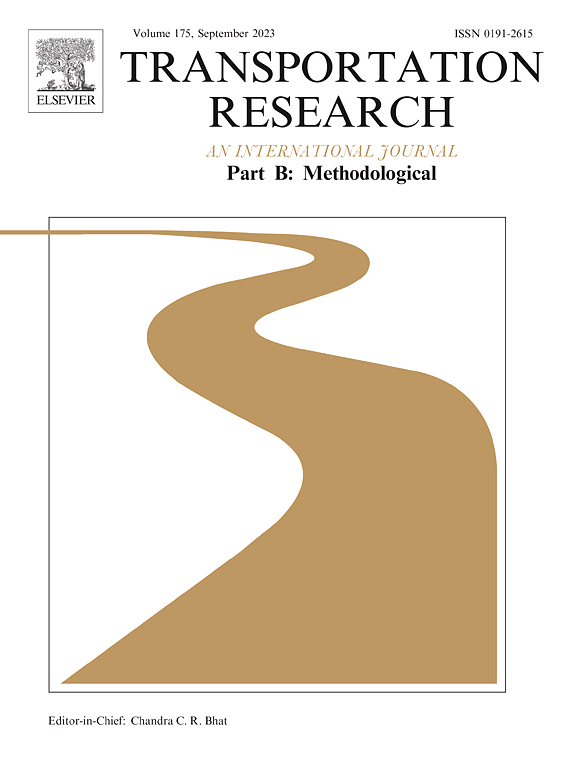航空公司客舱乘务员配对与跨舱位替代的准确表征:分支与价格法
IF 5.8
1区 工程技术
Q1 ECONOMICS
引用次数: 0
摘要
由于运营的飞机类型日益多样化,许多航空公司在制定客舱乘务员计划时已从传统的团队排班方法转为个人排班方法。个人排班法不仅能提高排班的灵活性,还能通过跨等级替代(即指派一名高等级乘务员替代一名低等级乘务员)更好地利用现有人力,这在近期大流行病后交通恢复导致的全行业人力短缺的情况下尤为重要。在本研究中,我们提出了一种新的乘务员配对方法,它能准确描述跨等级替代的特征。这种方法具有新颖性,因为它可以通过精确描述工作时间和成本来区分不同乘务员等级配对之间的替代关系。我们开发了一种分支加价格的解决方案。为实现对替代异质性的识别,我们构建了一个新的专门航班网络,该网络描述了每个航班上每个机组等级的特征。虽然新航班网络的规模会大幅增加,但它可以简化为在每次列生成迭代中只考虑每个航班的一个机组类别,而不会影响最优性。我们还提出了一种新的列固定分支策略,为新开发的非负整数变量模型确定整数解。我们基于实际收集的航班时刻表进行了计算实验,以验证所提方法在获得高质量解(例如,达到 0.01% 的优化差距)方面的性能。研究还考察了新机组配对方法的成本节约情况,结果表明,在不同的人力可用性水平和兼职成本设置下,成本节约情况差异很大。此外,我们还获得了丰富的管理启示。其中,我们发现,如果一个高船员等级直接替代一个低船员等级(例如,一个正在经历短缺的船员等级)的成本很高,那么可以通过一个中间船员等级提供间接帮助。本文章由计算机程序翻译,如有差异,请以英文原文为准。
Airline cabin crew pairing with accurate characterization of cross-class substitution: A branch-and-price approach
Given the increasing heterogeneity of the types of aircraft operated, many airlines have switched from the traditional team scheduling approach to the individual scheduling approach for cabin crew planning. The individual approach not only allows for greater scheduling flexibility, but also helps achieve better utilization of available manpower through cross-class substitution (i.e., assigning a high-class crew member to substitute a low-class crew member), which is especially important in view of the recent industry-wide manpower shortage led by the post-pandemic traffic recovery. In this study, we present a new crew pairing approach with accurate characterization of cross-class substitution. This approach is novel as it can distinguish the substitutions among different pairs of crew classes with precise characterization of work time and costs. We develop a branch-and-price solution approach. A new specialized flight network that characterizes each crew class for each flight is constructed to realize the recognition of substitution heterogeneity. Although the size of the new flight network increases dramatically, it can be simplified to consider only one crew class for each flight in each column generation iteration without affecting optimality. We also propose a new column-fixing branching strategy to identify integer solutions for the newly developed model with non-negative integer variables. Computational experiments based on real-world collected flight schedules are conducted to validate the performance of the proposed approach in obtaining high-quality solutions (e.g., achieving a 0.01% optimality gap). The cost saving of the new crew pairing approach is examined, which is shown to vary greatly across different manpower availability levels and part-time cost settings. Besides, rich managerial insights are derived. Among others, we find that if it is expensive for a high crew class to directly substitute a low class (e.g., one that is experiencing a shortage), indirect assistance can be provided through an intermediate class.
求助全文
通过发布文献求助,成功后即可免费获取论文全文。
去求助
来源期刊
CiteScore
12.40
自引率
8.80%
发文量
143
审稿时长
14.1 weeks
期刊介绍:
Transportation Research: Part B publishes papers on all methodological aspects of the subject, particularly those that require mathematical analysis. The general theme of the journal is the development and solution of problems that are adequately motivated to deal with important aspects of the design and/or analysis of transportation systems. Areas covered include: traffic flow; design and analysis of transportation networks; control and scheduling; optimization; queuing theory; logistics; supply chains; development and application of statistical, econometric and mathematical models to address transportation problems; cost models; pricing and/or investment; traveler or shipper behavior; cost-benefit methodologies.

 求助内容:
求助内容: 应助结果提醒方式:
应助结果提醒方式:


